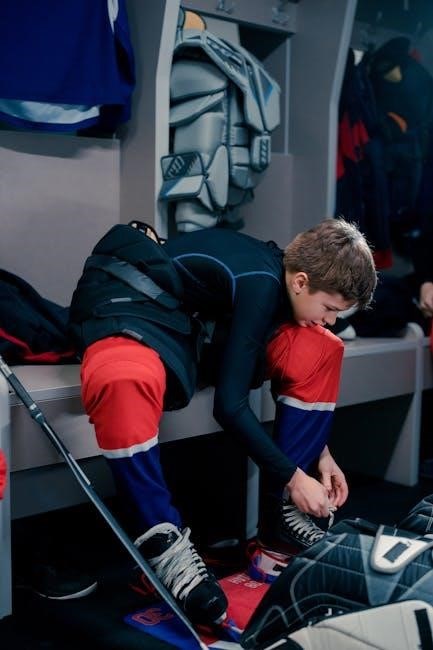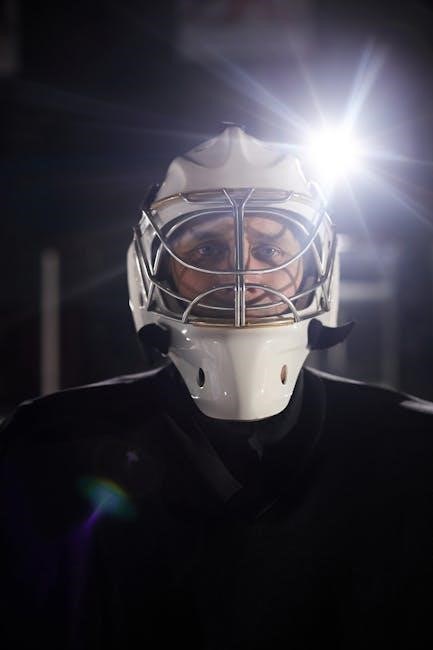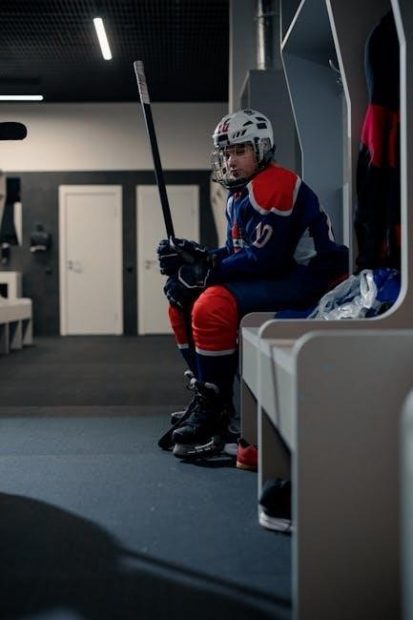Mastering hockey terminology is essential for players, fans, and officials to fully understand and appreciate the game. This guide provides a comprehensive overview of key terms, from basic concepts like “assist” and “power play” to advanced strategies and slang. Whether you’re a beginner or a seasoned enthusiast, this resource will enhance your knowledge and enjoyment of hockey culture and traditions.
1.1 Importance of Understanding Hockey Terms
Understanding hockey terminology is crucial for players, fans, and officials to fully grasp the game’s dynamics. It enhances communication, strategy execution, and overall enjoyment. Key terms like “assist,” “power play,” and “offside” are fundamental for analyzing plays and appreciating the sport’s complexity. Without a solid grasp of these terms, the game can be confusing and less engaging. This guide provides a clear and concise breakdown of essential hockey terms, ensuring everyone can participate in and enjoy the game with confidence.
1.2 Overview of Common Hockey Vocabulary
Common hockey vocabulary includes terms like “assist,” “power play,” and “offside,” which are fundamental to understanding the game. Other key phrases such as “backchecking,” “forechecking,” and “hat trick” describe essential strategies and achievements. Terms like “icing” and “breakaway” highlight specific game situations. These expressions are consistently used by players, coaches, and fans, making them crucial for effective communication and enjoyment of the sport. This guide provides clear definitions and explanations of these terms to help beginners and enthusiasts alike master the language of hockey.

Common Hockey Terms
Common hockey terms include “hat trick” (scoring three goals in a game), “breakaway” (a solo rush toward the goal), and “icing” (shooting the puck past the opponent’s goal line). These terms are essential for understanding game dynamics and strategies, enhancing both player and fan experiences. This guide provides clear definitions to help master the language of hockey effectively.
2.1 Basic Hockey Terms for Beginners
Understanding basic hockey terms is crucial for beginners. Key terms include assist (helping a teammate score), power play (attacking with a man advantage), and offside (crossing the blue line before the puck). icing occurs when a player shoots the puck from behind their own blue line and across the opponent’s goal line without scoring. A hat trick is when a player scores three goals in one game. These terms provide a foundation for grasping the game’s rules, strategies, and flow, making hockey more enjoyable for new players and fans alike.
2.2 Advanced Hockey Terminology
Advanced hockey terminology includes specialized terms like bar down (a shot hitting the crossbar and scoring) and deke (a deceptive move to trick opponents). Terms like forechecking (pressuring the opponent in their zone) and backchecking (defending against a rush) describe strategic plays. Breakout refers to moving the puck from defense to offense, while screen involves blocking the goalie’s view. Understanding these advanced terms helps players and fans grasp complex strategies and elevate their appreciation of the game’s nuances and tactics.

Player Positions in Hockey

In hockey, players are divided into forwards, defensemen, and a goaltender. Forwards score goals, defensemen protect the net, and the goaltender prevents the puck from entering the goal.
3.1 Forwards: Roles and Responsibilities
Forwards are responsible for scoring goals and maintaining puck possession in the offensive zone. The F1 is the first forward to enter the zone, often leading the rush, while the F2 provides support. Centers typically take face-offs and control play, while wingers use speed and agility to create scoring opportunities. Forwards must also backcheck to help the defense. Their primary goal is to outmaneuver opponents and create chances for goals, working in coordination with defensemen and the goaltender to achieve team success.
3.2 Defensemen: Key Duties and Strategies
Defensemen are crucial for protecting the net and preventing opponents from scoring. Their primary duties include blocking shots, intercepting passes, and maintaining defensive zone coverage. They often stay back during offensive rushes to ensure the puck doesn’t get past them. Defensemen also support the offense by joining the rush, setting up plays, and delivering precise passes. Effective defensemen read the game well, position themselves strategically, and communicate with teammates to maintain team structure and protect the goaltender. Their role is vital in both defensive and offensive strategies.
3.3 Goaltender: The Last Line of Defense
The goaltender is the final defender, responsible for preventing the puck from entering the net. They guard the crease, using their body, stick, and gloves to block shots. Goalies must read the play, anticipate opponents’ moves, and react quickly to high-speed shots. Their ability to freeze the puck during scrambles helps their team regain possession. Effective communication with defensemen is crucial for coordinating strategies. The goaltender’s performance often dictates the game’s outcome, making them a vital and skilled position in hockey.
Rules and Penalties in Hockey
Understanding hockey rules is crucial for players and fans. Key penalties include offside, icing, and high-sticking, each affecting gameplay and strategy significantly.
4.1 Understanding Offside and Icing
Offside occurs when a player enters the offensive zone before the puck, disrupting play. Icing is called when a player shoots the puck from behind their blue line and it crosses the goal line without being touched. Both rules aim to maintain fair play and flow. Offside violations result in a face-off in the neutral zone, while icing leads to a face-off in the defending team’s end zone, preventing long-range advantage.
4.2 Common Penalties and Their Definitions
Hooking involves using the blade of the stick to hook an opponent’s leg or body to slow them down. Holding occurs when a player grabs onto another player’s stick, jersey, or equipment with their hands or stick. Tripping is when a player uses their stick, leg, or body to cause an opponent to fall. Roughing includes physical altercations like shoving, pushing, or fighting. These penalties result in a power play for the opposing team, enhancing gameplay intensity and strategy.

Hockey Strategies and Systems
Explore essential strategies like offensive zone cycling, defensive zone coverage, and neutral zone regroups. These systems enhance team coordination and gameplay effectiveness, vital for success.
5.1 Power Play: Definition and Execution
A power play occurs when a team has a man advantage due to penalties against the opposing team. It is a strategic offensive opportunity to score. Teams often use coordinated plays, such as puck movement and player positioning, to create scoring chances. The power play unit typically includes the team’s most skilled players, focusing on quick passes and shots. Effective execution relies on communication, timing, and precision to outmaneuver the defense. Mastering power play strategies is crucial for capitalizing on scoring opportunities and gaining a competitive edge in the game.
5;2 Forechecking and Backchecking
Forechecking involves pressuring the opposing team in their defensive zone to regain puck possession quickly. It disrupts their ability to set up plays and creates turnovers. Players use agility and positioning to force errors. Backchecking, on the other hand, is defensive support provided by forwards when the opposing team transitions to offense. It involves tracking back, blocking shots, and intercepting passes to prevent scoring chances. Both strategies require strong skating, anticipation, and teamwork to effectively control the flow of the game and maintain defensive stability.

Hockey Culture and Slang
Hockey culture is rich in unique slang, enhancing fan engagement and camaraderie. Terms like “beauty” and “bar down” reflect the game’s vibrant language and traditions, fostering a shared identity among players and enthusiasts.
6.1 Popular Hockey Slang and Phrases
Hockey slang enriches the game’s culture, with phrases like “beauty” for a skilled player and “bar down” for a precise shot. Terms like “hat trick” (scoring three goals) and “snipe” (a powerful, accurate shot) are widely recognized. Other phrases, such as “five-hole” (the space between a goalie’s legs) and “tic-tac-toe” (a passing play), add flavor to game discussions. These expressions create a shared language, connecting fans and players in the hockey community.
6.2 Traditions and Superstitions in Hockey
Hockey is rich in traditions and superstitions that add depth to the game. Players often have pre-game rituals, like tapping the goalie’s pads for luck. The Stanley Cup playoffs feature beard-growing traditions, symbolizing commitment and unity. Superstitions, such as avoiding changes in equipment during a winning streak, are common. These customs, passed down through generations, create a unique culture that bonds players and fans, enhancing the game’s emotional and historical significance.
Visual Guides to Hockey Terminology
Visual guides, such as diagrams of the hockey rink and infographics, help players and fans understand key terms and strategies. These tools simplify complex concepts, making the game more accessible and enjoyable for everyone;
7.1 Diagrams of the Hockey Rink
Diagrams of the hockey rink are essential visual tools for understanding the game. They illustrate key areas such as the face-off circles, blue lines, and goal crease. These visuals help players and fans identify key zones and terminology, making it easier to grasp strategies and rules. The rink layout is clearly labeled, highlighting important features like the neutral zone and defending zones. Such diagrams are often included in hockey terminology PDF guides to provide a clear, interactive learning experience for beginners and enthusiasts alike.
7.2 Visual Explanations of Key Terms
Visual explanations of key hockey terms enhance understanding through diagrams and infographics. These tools, often found in hockey terminology PDF guides, illustrate concepts like offside, icing, and power plays. Charts and images break down complex strategies, such as forechecking and backchecking, making them easier to grasp. Visual aids also depict player positions and rink layouts, helping learners connect terms with their practical applications. This combination of visuals and definitions creates a comprehensive learning resource for mastering hockey terminology effectively.

Downloadable Hockey Terminology Resources
Enhance your understanding with downloadable hockey terminology PDF guides. These resources offer detailed charts, flashcards, and diagrams to master key terms and strategies effectively at your own pace.
8.1 Recommended PDF Guides for Beginners
For new players and fans, downloadable hockey terminology PDF guides are invaluable. These resources provide a structured approach to learning the game’s language, covering essential terms, definitions, and concepts. Many guides include diagrams of the rink, breakdowns of player positions, and explanations of key strategies like power plays and forechecking. They also offer exercises and quizzes to test your knowledge. Whether you’re learning the basics or refining your understanding, these PDFs are a convenient and comprehensive tool to master hockey terminology effectively.
8.2 Printable Charts and Flashcards
Enhance your learning with printable charts and flashcards designed to simplify hockey terminology. These visual tools organize key terms, strategies, and rink diagrams in an easy-to-understand format. Flashcards are ideal for quick memorization, while charts provide a comprehensive overview of concepts like player positions and penalties. Perfect for studying on the go or sharing with teammates, these resources make mastering hockey terminology both engaging and effective. They are a great supplement to PDF guides, offering a hands-on approach to learning the game’s essential language.
Further Learning and Resources
Explore online courses and expert forums to deepen your understanding of hockey terminology. Engage with communities, watch tutorials, and access detailed guides to become a true hockey expert.
9.1 Online Courses for Mastering Hockey Terms
Enhance your understanding of hockey terminology with structured online courses. These courses cover basic and advanced terms, offering video tutorials, interactive quizzes, and expert insights. Designed for all skill levels, they provide a comprehensive learning path to master hockey jargon, strategies, and cultural references. Many courses include downloadable materials, such as PDF guides and flashcards, to reinforce learning. Whether you’re a player, coach, or fan, these resources offer a flexible way to deepen your knowledge of the game.
9.2 Communities and Forums for Hockey Enthusiasts
Joining hockey communities and forums connects you with enthusiasts worldwide, fostering discussions on terminology, strategies, and game culture. Platforms like Reddit, Facebook groups, and specialized hockey forums offer spaces to ask questions, share resources, and learn from experienced players and fans. These communities often provide recommendations for the best PDF guides and tools to master hockey terms. Engaging with these networks can deepen your understanding and appreciation of the game, while also helping you stay updated on the latest trends and slang.
